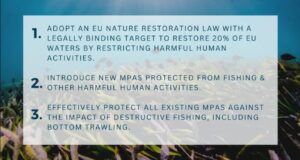by David Freedman Coral Reef Conservation and Biodiversity Awareness | Early Career Ocean Professional (ECOP)
The blue economy represents a significant investment opportunity to achieve sustainable development by leveraging the ocean’s vast resources.
It encompasses various sectors, each with the potential to drive economic growth while ensuring the health and sustainability of our oceans. Blue finance, focuses on funding initiatives that contribute to the blue economy.
In this article, we’ll explore the key sectors of the blue economy and how they can benefit from blue finance.
1. Aquaculture
Aquaculture, the farming of fish and other aquatic species, is the fastest-growing food production sector globally. It offers a promising solution to meet the rising demand for seafood without overexploiting wild fish stocks.
- Funding Sustainable Aquaculture: Blue finance can drive investment in environmentally friendly aquaculture technologies, such as recirculating systems that minimize waste and reduce environmental impact.
- Innovating Feed Solutions: Investment can also support the development of alternative feed sources that do not rely on wild fish, thus reducing pressure on marine ecosystems.
- Support for Fisheries Management: Funding can support better fisheries management systems, including data collection and monitoring, which are critical for maintaining fish populations.
2. Renewable Ocean Energy
The ocean is a vast and largely untapped source of renewable energy. Technologies such as offshore wind, wave, and tidal energy have the potential to play a significant role in the global energy transition.
- Capital for Infrastructure: Blue finance can provide the necessary capital for the development of renewable ocean energy infrastructure, such as offshore wind farms.
- Risk Mitigation: Investment in research and development can mitigate the risks associated with emerging ocean energy technologies, making them more attractive to investors.
3. Coastal Tourism
Coastal tourism is a major economic driver for many countries, especially those with abundant natural beauty. However, it also poses significant risks to marine environments if not managed sustainably.
- Sustainable Tourism Projects: Blue finance can support the development of eco-friendly tourism projects that minimize environmental impact, such as sustainable resorts and marine protected areas.
- Preserving Natural Assets: Investment can be directed towards conservation efforts that protect the natural assets that draw tourists, ensuring the long-term viability of coastal tourism.
4. Marine Biotechnology
Marine biotechnology involves the use of marine organisms to develop new products, ranging from pharmaceuticals to biofuels. This sector has enormous potential for innovation and economic growth.
- R&D Funding: Blue finance can fund research and development in marine biotechnology, helping to discover new applications for marine resources.
- Sustainable Harvesting: Investments can also support sustainable harvesting practices that ensure marine biodiversity is preserved while new products are developed.
5. Maritime Transport
Maritime transport is the backbone of global trade, with over 80% of international trade carried by sea. The sector is essential for global commerce but also a significant source of greenhouse gas emissions.
- Green Shipping Initiatives: Blue finance can support the development of cleaner shipping technologies, such as zero-emission vessels and alternative fuels.
- Port Infrastructure Improvements: Investment can also be directed towards enhancing port infrastructure to reduce environmental impacts and improve efficiency.
6. Seabed Mining
Seabed mining involves extracting minerals and resources from the ocean floor, such as cobalt, manganese, and rare earth elements, which are essential for renewable energy technologies and electronics. This sector has enormous potential, but environmental concerns remain high.
- Research into Sustainable Extraction: Blue finance can fund research into sustainable and less invasive seabed mining techniques, minimizing environmental impact.
- Regulatory Framework Development: Investment in developing stringent environmental safeguards and governance frameworks can ensure responsible resource extraction.
7. Ocean-Based Carbon Sequestration
The ocean is a crucial carbon sink, absorbing approximately 25% of annual carbon dioxide emissions. Ocean-based carbon sequestration technologies, such as seaweed farming and carbon capture methods, aim to enhance this natural process to combat climate change.
- Funding Innovative Solutions: Blue finance can support the development of scalable ocean-based carbon sequestration projects, which could play a key role in climate change mitigation.
- Research and Pilots: Investment can be directed toward pilot projects that test and refine these emerging technologies for wider implementation.
8. Desalination and Water Resource Management
As freshwater becomes increasingly scarce, desalination — the process of converting seawater into freshwater — is becoming more critical. Coastal communities are particularly reliant on this technology to meet water demands.
- Developing Energy-Efficient Solutions: Blue finance can help fund new desalination technologies that are more energy-efficient and have less impact on marine ecosystems.
- Water Infrastructure Investment: Investments can be made in water management systems that optimize the use and recycling of water resources in coastal regions.
9. Marine Pollution Control
Marine pollution, particularly plastic waste, poses a severe threat to ocean ecosystems. This sector focuses on reducing waste and plastic use, improving waste management systems, and promoting the circular economy.
- Waste Reduction Initiatives: Blue finance can fund companies and organizations that innovate plastic alternatives and promote waste reduction in coastal areas.
- Recycling and Cleanup Projects: Funding can also be directed towards large-scale marine cleanup projects and technologies that improve recycling rates.
The blue economy holds tremendous promise for sustainable development, but realizing this potential requires significant investment and commitment.
By aligning financial capital with the goals of the blue economy, we can ensure a thriving ocean that supports both people and the planet.
Sources:
- World Bank: The Potential of Blue Economy
- OECD: The Ocean Economy in 2030
- UNCTAD: Blue BioTrade
- WWF: Principles for a Sustainable Blue Economy
- FAO: The State of World Fisheries and Aquaculture
- International Seabed Authority: Deep Sea Mining
- [UNEP: Blue Carbon and Climate Change](https://www.unep.org/explore-topics/oceans-seas/what-we-do/working-regional-seas/blue-carbon




